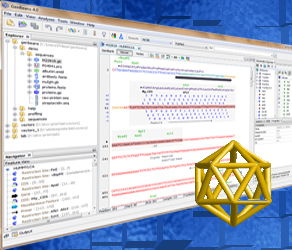ADVERTISEMENT
Ligand Docking
AutoDock is a suite of automated docking tools. It is designed to predict how small molecules, such as substrates or drug candidates, bind to a receptor of known 3D structure.
A freely-license molecular modeling, graphics, and drug design program.
UCSF DOCK is a program for finding and optimizing the structures of small molecules in protein or nucleic acid receptor sites.
ParDOCK is an all-atom energy based Monte Carlo,rigid protein ligand docking, implemented in a fully automated, parallel processing mode which predicts the binding mode of the ligand in receptor target site.
Protein-Protein Docking
Protein-Protein Docking Web Server for ranking of receptor-ligand complexes using energy filtering and clustering
The 3D-Dock Suite incorporates FTDock, RPScore and MultiDock. FTDock ( Fourier Transform Dock ) performs rigid-body docking on two biomolecules in order to predict their correct binding geometry. FTDock outputs multiple predictions that can be screened using biochemical information. FTDock implements the Fourier correlation algorithm of Katchalski-Katzir and coworkers plus an electrostatics function amenable to Fourier correlation that was developed in this laboratory.
A system for modelling protein-protein complexes based on conformational refinement of ensembles generated with the marching cubes algorithm.
This is the Web interface to our current protein docking software made available to the public. This software is different from the original GRAMM, except that both packages use FFT for the global search of the best rigid body conformations.
ESCHER Next Generation (NG) is an enhanced version of the original ESCHER protein-protein automatic docking system developed in 1997 by
DOT is a software package for docking macromolecules, including proteins, DNA, and RNA. DOT performs a systematic, rigid-body search of one molecule translated and rotated about a second molecule.
PyDockServer is a server for protein-protein docking.
The RosettaDock protein-protein docking server predicts the structure of protein complexes given the structures of the individual components and an approximate binding orientation.
HADDOCK (High Ambiguity Driven protein-protein DOCKing) is an information-driven flexible docking approach for the modeling of biomolecular complexes.
Sculptor is an interactive multi-resolution docking and visualization program for low-resolution density maps and atomic structures. We are developing Sculptor as a GUI-based extension of the Situs docking programs, to allow an interactive exploration and analysis of volumetric maps. Sculptor combines 3D rendering with advanced mathematical concepts like clustering techniques and pattern matching algorithms to permit an almost instantaneous fitting of the high-resolution structures and to facilitate typical post-processing work like map editing or resolution adjustment.
ZDOCK uses a fast Fourier transform to search all possible binding modes for the proteins, evaluating based on shape complementarity, desolvation energy, and electrostatics.
Molecular Docking Algorithm Based on Shape Complementarity Principles.
MolFit represents each molecule via a 3-dimensional grid of complex numbers and estimates the extent of geometric and chemical surface complementarity by correlating the grids.
The Web Bench
The Web Bench
is the essential companion to the biologist, bringing informational resources and a collection of tools & calculators to facilitate work at the bench and analysis of biological data.
Check out the full online bench here
Check out the full online bench here
Sequence Analysis with GenBeans
 Try GenBeans: Best free software for DNA sequence editing!
Try GenBeans: Best free software for DNA sequence editing!
FEEDBACK
Your comments & your suggestionsare appreciated. Please, notify us for resources and tools that you would like to see on this bench!





